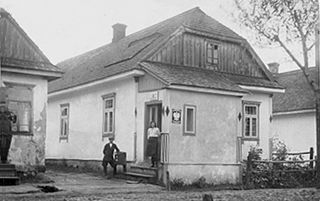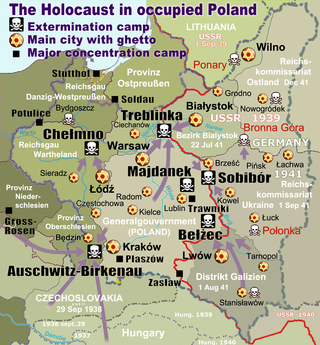Related Research Articles

Olyka is a rural settlement in Lutsk Raion, Volyn Oblast, western Ukraine. It is located east of Lutsk on the Putylivka Rriver. Its population is 3,032.

Yitzhak Arad was an Israeli historian, author, IDF brigadier general and Soviet partisan. He also served as Yad Vashem's director from 1972 to 1993, and specialised in the history of the Holocaust.
During World War II, resistance movements operated in German-occupied Europe by a variety of means, ranging from non-cooperation to propaganda, hiding crashed pilots and even to outright warfare and the recapturing of towns. In many countries, resistance movements were sometimes also referred to as The Underground.
Marcinkonys or Marcinkańce Ghetto was a small Jewish ghetto established during the Holocaust in Marcinkonys. It existed from around November 1941 to November 1942 and housed 300 to 400 Jews.

The Bielski partisans were a unit of Jewish partisans who rescued Jews from extermination and fought the German occupiers and their collaborators around Novogrudok and Lida in German-occupied Poland. The partisan unit was named after the Bielskis, a family of Polish Jews who organized and led the community.

The Vilna Ghetto was a World War II Jewish ghetto established and operated by Nazi Germany in the city of Vilnius in the modern country of Lithuania, at the time part of the Nazi-administered Reichskommissariat Ostland.
The history of the Jews during World War II is almost synonymous with the persecution and murder of Jews which was committed on an unprecedented scale in Europe and European North Africa. The massive scale of the Holocaust which happened during World War II greatly affected the Jewish people and world public opinion, which only understood the dimensions of the Final Solution after the war. The genocide, known as HaShoah in Hebrew, aimed at the elimination of the Jewish people on the European continent. It was a broadly organized operation led by Nazi Germany, in which approximately six million Jews were murdered methodically and with horrifying cruelty. Although the Holocaust was organized by the highest levels of the Nazi German government, the vast majority of Jews murdered were not German, but were instead residents of countries invaded by the Nazis after 1938. Of the approximately 6 million Jews murdered by the Nazis, approximately 160,000 to 180,000 were German Jews. During the Holocaust in occupied Poland, more than one million Jews were murdered in gas chambers of the Auschwitz concentration camp alone. The murder of the Jews of Europe affected Jewish communities in Albania, Austria, Belarus, Belgium, Bosnia & Herzegovina, Channel Islands, Croatia, Czech Republic, Estonia, France, Germany, Greece, Hungary, Italy, Latvia, Libya, Lithuania, Luxembourg, Moldova, the Netherlands, North Macedonia, Norway, Poland, Romania, Russia, Serbia, Slovakia, and Ukraine.

Jewish resistance under Nazi rule took various forms of organized underground activities conducted against German occupation regimes in Europe by Jews during World War II. According to historian Yehuda Bauer, Jewish resistance was defined as actions that were taken against all laws and actions acted by Germans. The term is particularly connected with the Holocaust and includes a multitude of different social responses by those oppressed, as well as both passive and armed resistance conducted by Jews themselves.

Trochenbrod or Trohinbrod, also in Polish: Zofiówka, or in Russian: Софиевка (Sofievka), in Ukrainian: Трохимбрід (Trokhymbrid), Hebrew: טרוכנברוד, was an exclusively Jewish shtetl – a small town, with an area of 1,728 acres (6.99 km2) – located in the gmina Silno, powiat Łuck of the Wołyń Voivodeship, in the Second Polish Republic and would now be located in Kivertsi Raion of Volyn Oblast in Ukraine. Following the invasion of Poland by Nazi Germany and the Soviet invasion of Poland in September 1939, Zofiówka was renamed in Russian and incorporated into the new Volyn Oblast of the UkSSR. Two years later, at the start of Operation Barbarossa in 1941, it was annexed by Nazi Germany into the Reichskommissariat Ukraine under a new Germanized name. Trochenbrod (Zofiówka) was completely eradicated in the course of German occupation and the ensuing Holocaust. The town used to be situated about 30 kilometres (19 mi) northeast of Lutsk. The nearest villages of today are Yaromel (Яромель) and Klubochyn (Клубочин).
Shalom Yoran was a survivor of the Holocaust and a former Jewish partisan. His World War II memoir, The Defiant. A True Story of Jewish Vengeance and Survival, was first published in 1996.
The Lenin Garrison was destroyed on 12 September 1942 during a partisan uprising against the Nazis.

The Dzyatlava Ghetto, Zdzięcioł Ghetto, or Zhetel Ghetto was a Nazi ghetto in the town of Dzyatlava, Western Belarus during World War II. After several months of Nazi ad-hoc persecution that began after the launch of Operation Barbarossa, the invasion of the Soviet Union, the new German authorities officially created a ghetto for all local Jews on 22 February 1942. Prior to 1939, the town (Zdzięcioł) was part of Nowogródek Voivodeship of the Second Polish Republic.

Tuvia Bielski was a Belarusian Jewish militant who was leader of the Bielski group, a group of Jewish partisans who set up refugee camps for Jews fleeing the Holocaust during World War II. Their camp was situated in the Naliboki forest, which was part of Poland between World War I and World War II, and which is now in western Belarus.

ŁachwaGhetto was a Nazi ghetto in Łachwa, Poland during World War II. The ghetto was created with the aim of persecution and exploitation of the local Jews. The ghetto existed until September 1942. One of the first Jewish ghetto uprisings had happened there.

Nikolay Yakovlevich Kiselyov, also commonly transliterated from the Russian language as Nikolai Kiselev, was a Soviet Red Army commissar, prisoner of war, and partisan leader during World War II.

Faye Schulman was a Jewish partisan photographer, and the only such photographer to photograph their struggle in Eastern Europe during World War II. Her full name was Faigel "Faye" Lazebnik Schulman.

The Słonim Ghetto was a Nazi ghetto established in 1941 by the SS in Slonim, Western Belarus during World War II. Prior to 1939, the town (Słonim) was part of the Second Polish Republic. The town was captured in late June 1941 by the Wehrmacht in the early stages of Operation Barbarossa. Anti-Jewish measures were promptly put into place, and a barb-wire surrounded ghetto had been created by 12 July. The killings of Jews by mobile extermination squads began almost immediately. Mass killings took place in July and November. The survivors were used as slave labor. After each killing, significant looting by the Nazis occurred. A Judenrat was established to pay a large ransom; after paying out 2 million roubles of gold, its members were then executed. In March 1942, ghettos in the surrounding areas were merged into the Słonim ghetto.
Benjamin Levin was a Jewish partisan during World War II, the last surviving member of the Avengers group led by Abba Kovner. After the war, he joined the Irgun, and was one of the surviving crew members of the Altalena ship. In 1967, he immigrated to the United States.

Baranavichy Ghetto was a ghetto created in August 1941 in Baranavichy, Belarus, with 8,000 to 12,000 Jews suffering from terrible conditions in six buildings. From March 4 to December 14, 1942, Germans killed nearly all of the Jews in the ghetto. Only about 250 survived the war, some of whom were helped by Hugo Armann, head of a unit that arranged travel for soldiers and security police. He saved six people from a murder squad and another 35 to 40 people who worked for him. Edward Chacza coordinated escapes with Armann and others so that Jews would meet up with partisan groups in the forest. He also provided food and arms.
Mira Shelub was a Jewish Polish resistance fighter. She fought against German forces on the eastern front of the second World War as part of a partisan group led by her husband. She has since spoken. She co-wrote a memoir about her experience in the resistance titled Never the Last Road (2015).
References
- 1 2 3 4 5 6 7 8 "Gertrude Boyarski | AmericansAll". americansall.org. Retrieved 2022-04-13.
- 1 2 3 4 5 6 7 "Gertrude Boyarski". encyclopedia.ushmm.org. Retrieved 2022-04-13.
- 1 2 "The Orders of Lenin and the Red Star established". Presidential Library. Retrieved 2022-04-14.
- ↑ "Operation Barbarossa | History, Summary, Combatants, Casualties, & Facts | Britannica". www.britannica.com. Retrieved 2022-04-14.
- ↑ "Gertrude Boyarski". Jewish Partisan Education Foundation. April 14, 2022. Retrieved April 14, 2022.
- 1 2 3 "WOMAN'S BRAVERY COMMEMORATED ON HOLOCAUST DAY - Document - Gale Power Search". go.gale.com. Retrieved 2022-04-15.